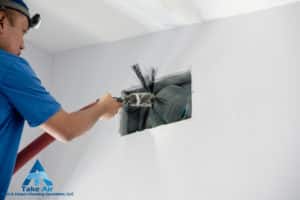Have you ever paid heed to the often-neglected ductwork in your home or office and wondered how it works? If you have, then you are not alone. In fact, many people are not aware of how duct cleaning works and how important it is to the overall efficiency of their HVAC system.
Ductwork is made up of a series of interconnected metal or plastic pipes that are used to transport air from the HVAC system to the various rooms in the building. The ductwork is typically hidden from view behind walls, ceilings, and floors, making it out of sight and out of mind for most people.
However, just because you can’t see the ductwork doesn’t mean that it doesn’t need to be cleaned on a regular basis. In fact, duct cleaning in Houston, TX, or anywhere else is a very important part of maintaining a healthy and efficient HVAC system.
Duct and vent cleaning is not a difficult or complicated process, but it is one that should be performed by a professional. This is because professional duct cleaners have the knowledge and experience necessary to properly clean all types of ductwork, including metal, plastic, and fiberglass ducts.
In this blog post, we are going to take a more in-depth look at how ductwork works and how professional duct cleaners at Take Air can keep your system clean and working properly.
How Duct and Vent Cleaning Works?
Step 1: Inspection:
Inspection is the first and most important step of professional duct cleaning. In this step, the technician will thoroughly inspect the ductwork to identify any areas that need to be cleaned. This inspection will also help the technician to determine the best way to clean the ductwork. The contractor will have special cameras that can be inserted into the ductwork to get a good look at the interior surfaces.
Step 2: Cleaning:
After the inspection is complete, the contractor will begin the cleaning process. This will usually involve the use of powerful vacuums and brushes to remove all of the dirt, dust, and debris from the ductwork. They use negative pressure vacuuming to prevent the spread of dirt and dust throughout your home or office. Negative pressure vacuuming works by using a powerful vacuum to remove all of the dirt and debris from the ductwork while at the same time sealing off the area so that the dirt and debris cannot escape back into the ductwork. While the system is under negative pressure, the contractor will also be able to clean any of the vents or registers that are attached to the ductwork. For instance, removing lint from dryer vents
Step 3: Cleaning the Other Components:
After the ductwork has been cleaned, an experienced technician will move on to cleaning the other components of your HVAC system. This includes the blower motor, the evaporator coils, and the condenser coils. These components are located inside of your air handler or furnace. The technician will use special brushes and vacuums to clean these components.
Step 4: Sanitizing:
NADCA-certified duct cleaning contractor will also sanitize the ductwork to remove any mold, mildew, or bacteria that may be present. They will use EPA-registered disinfectants and sanitizers to clean the ductwork and kill any harmful bacteria or mold.
Step 5: Reassembly and Final Testing:
Once the ductwork is clean and all of the other components have been cleaned, the contractor will begin the process of reassembling your HVAC system. This includes reconnecting all of the ductwork and testing the system to ensure that it is working properly.
Bottom line: How Duct and Vent Cleaning Works
Does your home or office in Houston, TX have ductwork? If so, then you should have it professionally cleaned on a regular basis. The best practice to get vent cleaning in Houston TX is to hire a company like Take Air that follows the NADCA guidelines. This will ensure that your ductwork is thoroughly cleaned and that all of the other components of your HVAC system are also cleaned. This will help to improve the indoor air quality of your home or office and make sure that your HVAC system is running efficiently.









